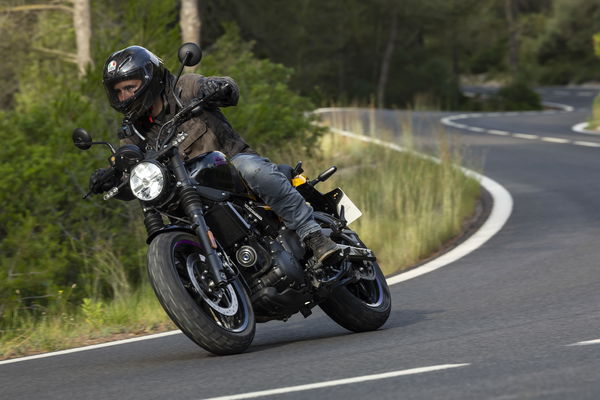2006 GSX-R600 K6 review
More power, less weight, and all wrapped in a GSX-R1000 looky-likey form. The 2006 Suzuki GSX-R600 K6 is bound to kick butt on-track - but can it deliver on the road?
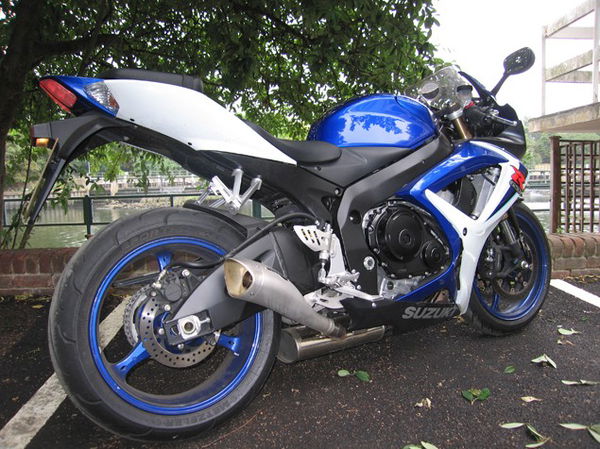
I was pleased when I heard my first ride on the 2006 Suzuki GSX-R600 would be on the road only - French roads, in fact - instead of the more usual track-based sportsbike launch. All new supersport bikes have impressive engine performance, plus they corner, steer and stop exceptionally well no matter what circuit you visit. It's only one's ability as a rider that defines how fast you circulate.
With engine and chassis performance at this level, being impressed on a track is a foregone conclusion. So I believe things have turned full circle and road manners are now equally important.
This hit home on the recent Triumph 675 Daytona launch when, after a day on the Sepang circuit, we took off into the countryside where it came up trumps as one of the best sportsbike I've ridden on the road.
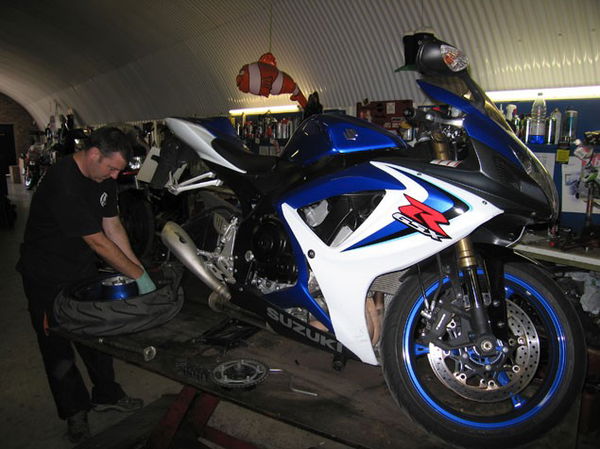
I never thought the K4/5 GSX R was the prettiest 600 out there, but the latest model is right up there with all the competition in the looks department.
Notwithstanding an aerodynamic improvement of five per cent, its combination of softer lines and flowing graphics make it instantly lovable, especially in white and metallic blue. Although the styling is very similar to the GSX-R1000s, its wee brother is much more compact with a thinner tail section, a lower seat height and smaller 16.5-litre tank.
Following on from the the 1000's love-it-or-loathe-it 'chubby' silencer, the new 600's pipe is a work of art. The stubby tail pipe is tucked neatly under the right footrest while the silencer blends in with the black belly pan directly under the engine.
As with all manufacturers, 'mass centralisation' is the theme throughout the sportsbike category.In line with this Suzuki has given its engine a stacked gearbox, making it 20mm smaller from top to bottom and 54mm from front to rear.
Weighing in at 161kg (dry weight, claimed by Suzuki) the nimble look is finished off nicely with some of the skinniest three-spoke wheels I've seen to date.
With bright sunshine in the sky but frost on the ground I was glad Jan had sneaked in some M&S thermals for my day-long thrash on the brilliant 'A' roads north of Beziers in south-western France.
The K6 GSX-R600 may look different but there's no mistaking that familiar growl when you hit the starter button. It's quite incredible that Suzuki manage to keep it sounding the same, considering how many engine changes have taken place.
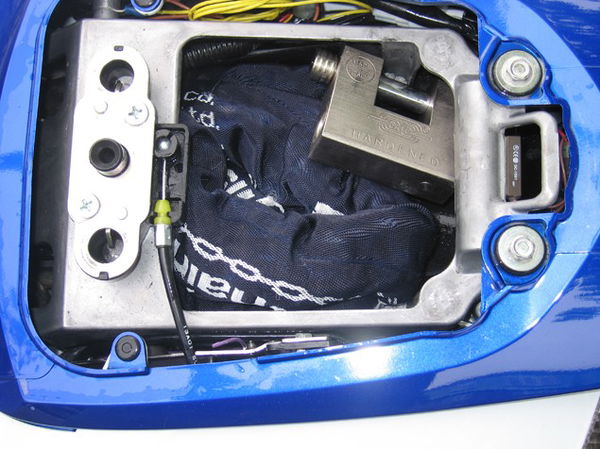
I gingerly set off, hoping to get some heat into the normally sticky BT014 Bridgestones and to discover whether this is a bike that is built for the road or the racetrack. Although there's no hesitation, the engine's fueling feels rich below 5000rpm, something I can only imagine comes from strangulation/noise reduction due to the latest emission requirements.
From 5000rpm to 10,000rpm there's a much cleaner, free-revving feeling, then from 10,000rpm to 16,000 you are in full banzai mode, more of which later.
Town and low speed riding was fine, even in high gears. The riding position is perfect for me, but a nice touch are the adjustable footpegs, which can be moved 14mm horizontally or vertically. This is such a good option, and could mean the difference between loving or hating the bike.
But it's out of built up areas where this bike comes alive.
Whether the surface is rough or smooth, the corners fast or slow, I could not fault the handling.
The K6 has a longer swingarm with its pivot moved forward to give more rider feel and less weight transfer. This was really evident; riding hard on the road is usually a compromise and getting the perfect suspension set-up is normally impossible. It was only at the end of the day I realised how faultless the handling was - from stability to quick flicks I never got into trouble.
I had already heard from some Yoshimura contacts in Japan that the standard suspension was impressive, and they were right. As with the suspension, the radial calipers and 310mm discs are 100 per cent consistent.
I found the rear quite easy to lock, but this may have been me not allowing for the slipper clutch to kick in.
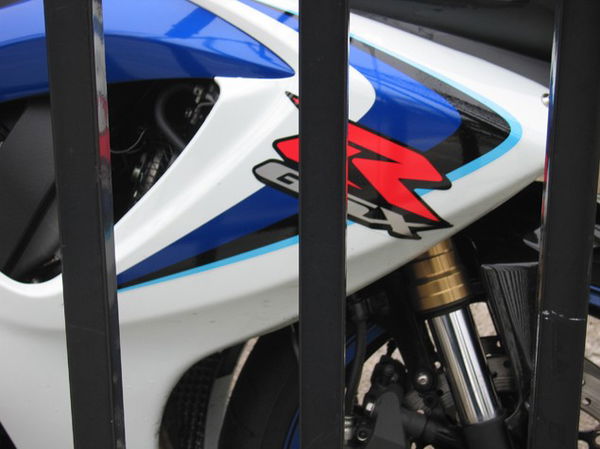
Show the GSX-R some open roads and it's like releasing a caged cheetah - this bike's desire to be thrashed just sucks you in and before you know it the speedo will be reading160mph.
With maximum power (125bhp claimed) appearing at 13,500rpm gearshifts are most productive at 14,500rpm.
I can believe this power figure too, since our engine guys at Crescent are working on a race motor that's already showing 138bhp.
The main power increase comes from bigger 40mm throttle bodies with twin injectors and a more efficient ram air system snorting through re-positioned ducts. A new curved, trapezoidal radiator also improves engine cooling.
The trouble with riding this bike - for me at least - is that there's no middle ground.
Sure, the engine is smooth and has a wide spread of power, but the unique sound and feel of the motor between 10,000 and 15,000rpm is addictive. Trying to ride outside these parameters means continually shifting gears - which becomes tiresome after a while - so before you know it you're back in the naughty zone.
On the up side there's now a gear position indicator which is handy since it's easy to lose track of which gear you're in. There is also a shift light and reserve fuel trip countdown.

Should you buy the Suzuki GSX-R600 K6 (2006)?
So is this a brilliant road bike? The answer is 'yes' if you want to ride fast and the answer 'yes' if you want to ride slow.
But if you want to ride somewhere in between I'm not so sure. The GSX-R600 is a beautiful animal with pin-sharp brakes and handling plus a glorious engine. Its road manners are good, but to unleash all the potential it needs to be taken to its natural habitat: the race track.
Suzuki GSX-R600 K6 (2006) specs
| Dryweight (kg) | 161 |
| Seats | 2 |
| Seat Height (mm) | 810 |
| Suspension Front | Inverted forks |
| Suspension Rear | Monoshock |
| Adjustability Front | Fully Adjustable |
| Adjustability Rear | Fully Adjustable |
| Tyres Front | 120/70-17 |
| Tyres Rear | 180/55-17 |
| Brakes Front | Twin 310mm discs, four piston radial calipers |
| Brakes Rear | Single 220mm disc, single piston caliper |
| Tank Capacity (litres) | 16.5 |
| Wheelbase (mm) | 1400 |
| Rake (degrees) | 23.8 |
| Trail (mm) | 97 |
| Chassis | Aluminium beam |
| Colours | Blue/white, Black/grey, Black |
| Cubic Capacity (cc) | 599 |
| Max Power (bhp) | 125 |
| Max Power Peak (rpm) | 13500 |
| Torque (ft/lb) | 50 |
| Torque Peak (rpm) | 7000 |
| Bore (mm) | 67 |
| Stroke (mm) | 42.5 |
| Compression Ratio | 12.5 |
| Valves Per Cylinder | 4 |
| Cooling | Liquid |
| Fuel Delivery | Fuel Injection |
| Stroke Type | Four Stroke |
| Drive | Chain |
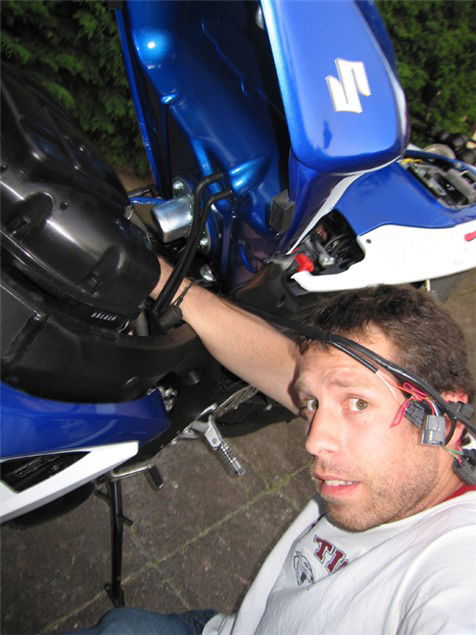
Living with the Suzuki GSX-R600 K6 (2006)
July 2006
To be truthful so far I'm not really enjoying running the GSX-R600. It's nothing to do with the bike, the problem is I'm so convinced the GSX-R will be stolen that it's changing the way I use it.
If a mate calls up asking if I want to meet somewhere I'm starting to avoid using the Suzuki because I'm so scared it will be nicked. With every other bike I've owned this hasn't been a problem, but the GSX-R just seems destined to be lifted. I even left a bank queue I'd been standing in for half an hour the other day because I heard the alarm going off, but more of that later.
So, in an effort to ease my paranoia, I've started turning the Suzuki into a mobile fortress. With the toolkit out (I have AA coverage) a large ABUS chain and lock coils up neatly in the space under the pillion seat and, against my better judgement, I've fitted an alarm.
Personally I hate alarms. Every time I ride a second-hand bike that has one fitted it goes wrong. Well, this was going to be different, or so I thought. It took about an hour for the mechanic to fit the Acumen Cat 1 alarm (£299, fitted at a location of your choice), and it's a really neat job with the alarm tucked away.
Suzukis come with a built in immobiliser - a chip in the key is recognised by sensors in the ignition barrel. Acumen supply the alarm with a key fob which has a space for this chip, and some blank Suzuki keys so you can combine the fob and bike key. A neat idea, although it means abandoning the Suzuki key for a bloody great alarm fob. The only problem I've found is that getting the steering lock on and off is harder because the Acumen fob doesn't have the strength of the Suzuki key, and it tends to bend a bit.
Then there's the alarm. Within a day it started going off for no apparent reason, not good for my already shot nerves. A call to Acumen and a fixer man came and diagnosed a faulty motion sensor, which he fixed and now the alarm is working fine.
But at the end of the day why should I be constantly worried about my bike being stolen? Thieving twats are ruining my enjoyment of the bike, and this really pisses me off.
August 2006
In nature things that you shouldn't touch are brightly coloured. Poisonous tree frogs are red, wasps are yellow. You know the score - bright colours mean 'don't mess with me because I will cause you pain and suffering'. Is it any coincidence that wiring looms are also brightly coloured? I think not.
I usually avoid trying to fit anything electrical because it often results in a bang, acrid smoke and a non-running bike. But for some reason I decided to be brave with the Power Commander.
So, instructions in hand, I approached the GSX-R. Tank up? No problem (the Suzuki even has a little prop stand). Then came unplugging the injectors. What a nightmare. Sports bikes are designed to be as compact as possible, which means you need treble-jointed arms and the hands of a small child to get anywhere near the connectors. Unfortunately I didn't have any small children around but after about half an hour of contortions (during which I lost most of the skin on my arms) and a lot of swearing, I managed to get the connectors off and the Power Commander fitted. Job done.It only took an hour in total, and I have to say was considerably easier than I thought it would be. A mechanic would have charged around £30 to fit it and it's a job you can easily do at home. All I need to do now is get the bike properly set up on a dyno - I'll let you know how I get on next month.
As you have probably spotted elsewhere in this mag, the GSX-R has been on holiday to the south of France, which I'm sure it enjoyed as it came back relatively unscathed. Something it didn't enjoy quite as much was the 0-100-0 test that it was involved with. There will be more on this in next month's mag, but basically it involves setting a time as fast as possible going from stationary to 100mph then back to stationary again. In the hands of Whitham the GSX-R did well, but unfortunately the clutch didn't. Riding home the other day I decided to pop a quick wheelie, only to be rewarded by an increase of revs as the clutch slipped instead of biting. Great. There goes my fun.
October 2006
After two weeks commuting on a Deauville the return of the GSX-R (with a new clutch and brake discs) was more than eagerly awaited. I'd forgotten you can actually have fun on a daily commute.
Anyway, first day back I'm sitting at home and John Hogan rings to let me know he's just harpooned a car with his GSR and could he please have a lift to work as his bike now crabs a bit (due to its headstock no longer being attached to the frame). It's been a while since I took a pillion and the 20-mile run to work with Hogan put me in mind of two things. Firstly, if the next girlfriend weighs over 15-stone I may have to trade the GSX-R because it doesn't handle too well with this much weight on the back. And secondly, the fuel injection needs sorting out.
Riding on my own I'm a lot more aggressive with the throttle so it's not something I really notice so much, but trying to be smooth with a pillion the GSX-R has a horrible snatch and lurch going from closed to small throttle openings. It's time I got round to getting the Power Commander set up.
A trip to central London dyno house Banjax (0207 377 6333) revealed that, much to my surprise, I had actually fitted the Power Commander correctly. However, as Martin at Banjax explained, the fueling on the GSX-R would also take a bit more work in order to be properly sorted. The problem is the funky under-engine exhaust. Because it's so rammed full of catalysers and assorted emissions gubbins the dyno's exhaust gas sensor can't get an accurate reading, making it hard to set up the bike. The guys at Banjax did the best they could but reckoned an aftermarket system, even a road legal one, would give a better results.
With the work Banjax did the GSX-R felt better than standard, especially the low rev range which has lost some of its fluffy feeling. But it's by no means fixed. Time for an aftermarket can.
A call to Micron (01773 876330) sorted a road legal MotoGP-style can and silencer. Costing £279.99 it comes with a stubby pipe and new collector box that weighs 1.6kg less than the original unit.
Flushed with the success of fitting the Power Commander correctly I got the tools out again. Removing a modern fairing is usually a nightmare, but instead of the usual array of bolts and washers the GSX-R has a lot of push-fit panel connectors, which makes it a lot easier to get off.
Three bolts and a clamp removed saw the standard exhaust off the bike and on my workbench, and 10 minutes later the new collector box was in place. Result. Well done me.
Now for the end can. At this point I made a discovery: my GSX-R has adjustable footpegs! I think I knew it had these already, but I had filed it away in the recesses of my mind because I find the standard position comfortable enough. But it's good to know anyway. So, Micron's bracket fitted neatly behind the footpeg hanger assembly and the new pipe was on. It looks very neat, the instructions are clear and I like the fact Micron has supplied new Allen bolts rather than having to reuse the reasonably horrible standard fittings the Suzuki uses.
Next month I'll get the GSX-R back on the dyno for a proper run and full fueling sort-out.
December 2006
Hands up, I admit it, I've been a lazy git this month when it comes to the GSX-R. Fair play, the 4000 miles to Moscow and back by GS Adventure is something to do with the lack of progress on the Suzuki, but for the last month I've just been using it as a day-to-day hack rather than trying to sort it out. So with the Micron pipe installed I returned to Banjax in an effort to beat the fueling irritations once and for all.
Back on the dyno again and being catalyser free the Micron pipe allows the sensor to get an accurate reading, meaning BHP's dyno-man Martin could actually work hiswonders. I reckon my little Suzuki has now probably done about 100 miles and over 120 runs on a rolling road, but it's been worth it.
First run of the day showed something staggering: the road legal Micron pipe had added nearly 10bhp to the GSX-R, with it now showing 110bhp. That's a hell of a power increase, and shows what a mess catalysers make of the flow of gases through a pipe. Aftermarket pipes don't have cats so although it is road legal sound wise, the Micron doesn't have the huge honeycomb mess of catalysing stuff in it, so allowing the gases to flow through unrestricted and unleash more power.
About an hour of dyno work and the fuel map was far nearer to what it should be, and although peak power had dropped slightly to 109bhp (it was running a bit lean at the top end before - lean means more power but increased risk of a lunched piston) the fueling should be about perfect.
So with the mid-range improved and the bike fueling correctly we attacked the annoying throttle snatch. Using Tim's tactics that worked so well on his Fazer we upped the fuel accelerator pump so it ran richer while reducing its sensitivity. Has it worked? It's better, but still needs some fine-tuning, I'll keep you posted and have it sorted by next month. Promise.
Finally, I found another reason to hate Ikea. As if there weren't enough reasons to despise this version of Swedish torture, on the way home my lovely Metzeler Sportec M3 rear tyre (£200 a set, call 0845 6094949), which I put on about a month ago, picked up a puncture. Luckily enough I was about two miles from a bike shop, which I made it to with a tyre resembling a pancake. What did I find in the rear? One of those cheap bloody Ikea flat pack screws that's used to hold together their crap furniture! What the hell was that doing on the road?
The only answer I can come up with is that someone threw a half-built Ikea bedside table out of their car window in frustration, something I can totally understand...
February 2007
I've had some e-mails asking what the GSX-R's build quality is like. Suzuki's don't have the best reputation for the quality of their finish, and in the current bike buying market this is enough to sway sales. Buyers are tending to hold onto their machines for longer because they don't have the spare cash to keep changing bikes. So when considering a new bike, what it's going to look like in three years time is a big issue. Forking out just shy of £7000 for something that will look like a nail when the time comes to sell just isn't acceptable, especially when the competition is so close on price and performance.
With this in mind I spent a few hours poking around the GSX-R to see if Suzuki's reputation is well founded. Now I'm not one of those dedicated fellows who actually enjoys cleaning bikes, so I admit the Suzuki hasn't been pampered every weekend with a nice bath and spruce up. It has over 8000 miles on the clock, has been used daily, is seldom cleaned and it's left outside most of the time because I've just put a pool table in the garage. This bike has had a hard life.
So, after giving it a nice Muc-Off bath to expose the shiny bits, what's the result? First up is the fairing. Suzukis in the past, and especially GSX-Rs, have been known to have pretty poorly applied decals, usually without any lacquer protecting them. This seems to have been sorted because apart from a few stone chips (not really Suzuki's fault) the GSX-R's fairing is perfect.
Moving down, the cylinder head is a nice black colour, which hides any marking, and unlike Niall's Triumph 675 the metal of the cylinders seems corrosion free. The black painted frame still looks factory fresh, as does the swingarm, but the wheels aren't that impressive.
It seems that no matter how careful you are, any tyre change results in chipped rims and flaking wheel paint. Both the front and rear wheels have chips in them and I've only had the tyres changed once. Not very impressive.
While I'm down there, the rear axle nut has already succumbed to corrosion, as have the brake line banjos and banjo bolts, and the fork pinch bolts. And it's barely winter, so this corrosion is simply due to use, not road salt. Also poor is the blue anodised finish on the fork spring preload adjusters, which disappears at the first sign of a spanner.
But here is the strange part: some bits of the bike are really good. Areas like the footrest mounting point, gear linkage, radiator and any exposed metal parts on the engine are still in really good condition, and the engine bolts look really good quality. It's almost as if Suzuki has upped the quality of some components but skimped on others. Parts that are unique to the GSX-R range seem to be better quality, but parts that are universal to a few other bikes in the range are lacking.
Putting myself in a potential owner's position the only real irritation with the build quality is the wheels. To be truthful most older GSX-Rs that I've seen have steel braided lines, race exhausts (before I removed it the stock collector box looked fairly poor quality and the downpipes are a bit rusty) and bolt kits fitted, it's just that kind of bike. The fact the major components - frame, swingarm, engine - look good after a decent mileage is reassuring. If I owned the bike I would probably swap the nasty bolts for nice stainless ones (not anodised blue!) and fit braided brake lines with stainless steel fittings, which would make a world of difference. As for the wheels? Well I'd just have to keep a tub of Suzuki blue touch up paint on hand and tell the tyre changer to be extra careful!

